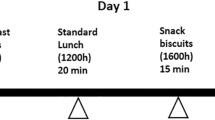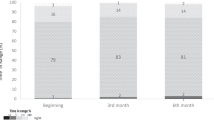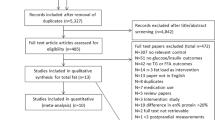Abstract
Background/objective:
The Food Insulin Index (FII) is a novel algorithm for ranking foods on the basis of insulin responses in healthy subjects relative to an isoenergetic reference food. Our aim was to compare postprandial glycemic responses in adults with type 1 diabetes who used both carbohydrate counting and the FII algorithm to estimate the insulin dosage for a variety of protein-containing foods.
Subjects/methods:
A total of 11 adults on insulin pump therapy consumed six individual foods (steak, battered fish, poached eggs, low-fat yoghurt, baked beans and peanuts) on two occasions in random order, with the insulin dose determined once by the FII algorithm and once with carbohydrate counting. Postprandial glycemia was measured in capillary blood glucose samples at 15–30 min intervals over 3 h. Researchers and participants were blinded to treatment.
Results:
Compared with carbohydrate counting, the FII algorithm significantly reduced the mean blood glucose level (5.7±0.2 vs 6.5±0.2 mmol/l, P=0.003) and the mean change in blood glucose level (−0.7±0.2 vs 0.1±0.2 mmol/l, P=0.001). Peak blood glucose was reached earlier using the FII algorithm than using carbohydrate counting (34±5 vs 56±7 min, P=0.007). The risk of hypoglycemia was similar in both treatments (48% vs 33% for FII vs carbohydrate counting, respectively, P=0.155).
Conclusions:
In adults with type 1 diabetes, compared with carbohydrate counting, the novel FII algorithm improved postprandial hyperglycemia after consumption of protein-containing foods.
This is a preview of subscription content, access via your institution
Access options
Subscribe to this journal
Receive 12 print issues and online access
$259.00 per year
only $21.58 per issue
Buy this article
- Purchase on Springer Link
- Instant access to full article PDF
Prices may be subject to local taxes which are calculated during checkout


Similar content being viewed by others
References
Evert AB, Boucher JL, Cypress M, Dunbar S, Franz MJ, Mayer-Davis EJ et al. Nutrition therapy recommendations for the management of adults with diabetes. Diabetes Care 2014; 37 (Suppl 1): S120–S143.
Ahola AJ, Makimattila S, Saraheimo M, Mikkila V, Forsblom C, Freese R et al. Many patients with type 1 diabetes estimate their prandial insulin need inappropriately. J Diabetes 2010; 2: 194–202.
Ahern J, Gatcomb P, Held N, Petit W, Tamborlane W . Exaggerated hyperglycemia after a pizza meal in well-controlled diabetes. Diabetes Care 1993; 16: 578–580.
MacDonald K, Lowe JM, Barker D, Mensch M, Attia J . Effect of popular takeaway foods on blood glucose levels in type 1 diabetes mellitus patients on intensive insulin therapy. Int J Clin Pract 2009; 63: 189–194.
Wolpert HA, Smith SA, Atakov-Castillo A, Steil GM . Dietary fat acutely increases glucose concentrations and insulin requirements in patients with type 1 diabetes: implications for carbohydrate-based bolus dose calculation and intensive diabetes management. Diabetes Care 2013; 36: 810–816.
Smart CEM, Lopez PE, Evans M, Jones TW, O’Connell SM, Davis EA et al. Both dietary protein and fat increase postprandial glucose excursions in children with type 1 diabetes and the effect is additive. Diabetes Care 2013; 36: 3897–3902.
Bao J, Atkinson F, Petocz P, Brand-Miller J . Prediction of postprandial glycemia and insulinemia in lean, young, healthy adults: glycemic load compared with carbohydrate content alone. Am J Clin Nutr 2011; 93: 984–986.
Bao J, de Jong V, Atkinson F, Petocz P, Brand-Miller JC . Food insulin index: physiologic basis for predicting insulin demand evoked by composite meals. Am J Clin Nutr 2009; 90: 986–992.
Nimptsch K, Kenfield S, Jensen M, Stampfer M, Franz M, Sampson L et al. Dietary glycemic index, glycemic load, insulin index, fiber and whole-grain intake in relation to risk of prostate cancer. Cancer Causes Control 2011; 22: 51–61.
Bao J, Gilbertson HR, Gray R, Munns D, Howard G, Petocz P et al. Improving the estimation of mealtime insulin dose in adults with type 1 diabetes: the Normal Insulin Demand for Dose Adjustment (NIDDA) study. Diabetes Care 2011; 34: 2146–2151.
Franz MJ . Protein: metabolism and effect on blood glucose levels. Diabetes Educ 1997; 23: 643–646.
Monnier L, Lapinski H, Colette C . Contributions of fasting and postprandial plasma glucose increments to overall diurnal hyperglycaemia of type 2 diabetic patients—variations with increasing levels of HbA1c. Diabetes Care 2003; 26: 881–885.
Brownlee M, Hirsh I . Glycemic variability: a hemoglobin A1c-independent risk factor for diabetic complications. JAMA 2006; 295: 1707–1708.
Lee S, Cao M, Sajid S, Hayes M, Choi L, Rother C et al. The dual-wave bolus feature in continuous subcutaneous insulin infusion pumps controls prolonged post-prandial hyperglycaemia better than standard bolus in type 1 diabetes. Diabetes Nutr Metab 2004; 17: 211–216.
Chase H, Saib S, MacKenzi T, Hansen MM, Garg SK . Postprandial glucose excursions following four methods of bolus insulin administration in subjects with type 1 diabetes. Diabetes Med 2002; 19: 2146–2151.
O’Connell M, Gilbertson H, Donath S, Cameron FJ . Optimizing postprandial glycemia in pediatric patients with type 1 diabetes using insulin pump therapy. Diabetes Care 2008; 31: 1491–1495.
Heinemann L . Insulin pump therapy: What is the evidence for using different types of boluses for coverage of prandial insulin requirements? J Diabetes Sci Technol 2009; 3: 1490–1500.
Nuttall FQ, Gannon MC, Wald JL, Ahmed M . Plasma glucose and insulin profiles in normal subjects ingesting diets of varying carbohydrate, fat, and protein content. J Am Coll Nutr 1985; 4: 437–450.
Anderwald C, Artwohl M, Bischof M, Brehm A, Brunmair B, Furnsinn C et al. The mammalian target of rapamycin pathway regulates nutrient-sensitive glucose uptake in man. Diabetes 2007; 6: 1600–1607.
Weickert MO, Roden M, Isken F, Hoffmann D, Nowotny P, Osterhoff M et al. Effects of supplemented isoenergetic diets differing in cereal fiber and protein content on insulin sensitivity in overweight humans. Am J Clin Nutr 2011; 94: 459–471.
Savage DB, Petersen KF, Shulman GI . Disordered lipid metabolism and the pathogenesis of insulin resistance. Physiol Rev 2007; 87: 507–520.
Diabetes Control and Complications Trial Research Group. The effect of intensive treatment of diabetes on the development and progression of long-term complications in insulin-dependent diabetes mellitus. The Diabetes Control and Complications Trial Research Group. N Engl J Med 1993; 329: 977–986.
Collier GR, Greenberg GR, Wolever TMS, Jenkins DJA . The acute effect of fat on insulin secretion. J Clin Endocrinol Metab 1988; 66: 323–326.
Acknowledgements
Support for this study was provided by the University of Sydney. This study has been presented at the American Diabetes Association 73rd Scientific Sessions, Chicago, IL, USA, 21–25 June 2013.
Author information
Authors and Affiliations
Corresponding author
Ethics declarations
Competing interests
The authors declare no conflict of interest.
Rights and permissions
About this article
Cite this article
Bell, K., Gray, R., Munns, D. et al. Estimating insulin demand for protein-containing foods using the food insulin index. Eur J Clin Nutr 68, 1055–1059 (2014). https://doi.org/10.1038/ejcn.2014.126
Received:
Revised:
Accepted:
Published:
Issue Date:
DOI: https://doi.org/10.1038/ejcn.2014.126
This article is cited by
-
Postprandial glucose metabolism in children and adolescents with type 1 diabetes mellitus: potential targets for improvement
European Journal of Clinical Nutrition (2024)
-
The association between dietary insulin index and load with mental health
BMC Psychology (2022)
-
Engineering digital biomarkers of interstitial glucose from noninvasive smartwatches
npj Digital Medicine (2021)
-
Capillary blood reference intervals for platelet parameters in healthy full-term neonates in China
BMC Pediatrics (2020)
-
The Role of Dietary Protein and Fat in Glycaemic Control in Type 1 Diabetes: Implications for Intensive Diabetes Management
Current Diabetes Reports (2015)



